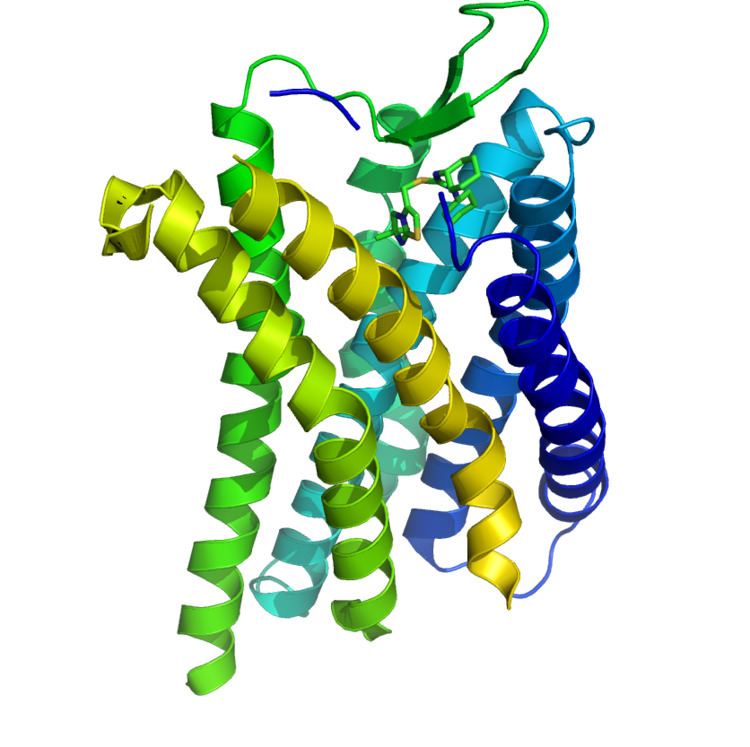Entrez 7852 | Ensembl ENSG00000121966 | |
 | ||
Aliases CXCR4, CD184, D2S201E, FB22, HM89, HSY3RR, LAP-3, LAP3, LCR1, LESTR, NPY3R, NPYR, NPYRL, NPYY3R, WHIM, WHIMS, C-X-C motif chemokine receptor 4 External IDs OMIM: 162643 MGI: 109563 HomoloGene: 20739 GeneCards: CXCR4 | ||
C-X-C chemokine receptor type 4 (CXCR-4) also known as fusin or CD184 (cluster of differentiation 184) is a protein that in humans is encoded by the CXCR4 gene.
Contents
Function
CXCR-4 is an alpha-chemokine receptor specific for stromal-derived-factor-1 (SDF-1 also called CXCL12), a molecule endowed with potent chemotactic activity for lymphocytes. CXCR4 is one of several chemokine receptors that HIV can use to infect CD4+ T cells. HIV isolates that use CXCR4 are traditionally known as T-cell tropic isolates. Typically, these viruses are found late in infection. It is unclear as to whether the emergence of CXCR4-using HIV is a consequence or a cause of immunodeficiency.
CXCR4 is upregulated during the implantation window in natural and hormone replacement therapy cycles in the endometrium, producing, in presence of a human blastocyst, a surface polarization of the CXCR4 receptors suggesting that this receptor is implicated in the adhesion phase of human implantation.
CXCR4's ligand SDF-1 is known to be important in hematopoietic stem cell homing to the bone marrow and in hematopoietic stem cell quiescence. It has been also shown that CXCR4 signalling regulates the expression of CD20 on B cells. Until recently, SDF-1 and CXCR4 were believed to be a relatively monogamous ligand-receptor pair (other chemokines are promiscuous, tending to use several different chemokine receptors). Recent evidence demonstrates ubiquitin is also a natural ligand of CXCR4. Ubiquitin is a small (76-amino acid) protein highly conserved among eukaryotic cells. It is best known for its intracellular role in targeting ubiquitylated proteins for degradation via the ubiquitin proteasome system. Evidence in numerous animal models suggests ubiquitin is anti-inflammatory immune modulator and endogenous opponent of proinflammatory damage associated molecular pattern molecules. It is speculated this interaction may be through CXCR4 mediated signalling pathways. MIF is an additional ligand of CXCR4
CXCR4 is present in newly generated neurons during embryogenesis and adult life where it plays a role in neuronal guidance. The levels of the receptor decrease as neurons mature. CXCR4 mutant mice have aberrant neuronal distribution. This has been implicated in disorders such as epilepsy.
Clinical significance
Drugs that block the CXCR4 receptor appear to be capable of "mobilizing" hematopoietic stem cells into the bloodstream as peripheral blood stem cells. Peripheral blood stem cell mobilization is very important in hematopoietic stem cell transplantation (as a recent alternative to transplantation of surgically harvested bone marrow) and is currently performed using drugs such as G-CSF. G-CSF is a growth factor for neutrophils (a common type of white blood cells), and may act by increasing the activity of neutrophil-derived proteases such as neutrophil elastase in the bone marrow leading to proteolytic degradation of SDF-1. Plerixafor (AMD3100) is a drug, recently approved for routine clinical use, which directly blocks the CXCR4 receptor. It is a very efficient inducer of hematopoietic stem cell mobilization in animal and human studies.
It has been associated with WHIM syndrome. WHIM like mutations in CXCR4 were recently identified in patients with Waldenstrom's macroglobulinemia, a B-cell malignancy. The presence of CXCR4 WHIM mutations has been associated with clinical resistance to ibrutinib in patients with Waldenstrom's Macroglobulinemia.
While CXCR4’s expression is low or absent in many healthy tissues, it was demonstrated to be expressed in over 23 types of cancer, including breast cancer, ovarian cancer, melanoma, and prostate cancer. Expression of this receptor in cancer cells has been linked to metastasis to tissues containing a high concentration of CXCL12, such as lungs, liver and bone marrow. However, in breast cancer where SDF1/CXCL12 is also expressed by the cancer cells themselves along with CXCR4, CXCL12 expression is positively correlated with disease free (metastasis free) survival. CXCL12 (over-)expressing cancers might not sense the CXCL12 gradient released from the metastasis target tissues since the receptor, CXCR4, is saturated with the ligand produced in an autocrine manner. Another explanation of this observation is provided by a study that shows the ability of CXCL12 (and CCL2) producing tumors to entrain neutrophils that inhibit seeding of tumor cells in the lung.
Drug response
Chronic exposure to THC has been shown to increase T lymphocyte CXCR4 expression on both CD4+ and CD8+ T lymphocytes in rhesus macaques. It has been shown that BCR signalling inhibitors also affect CXCR4 pathway and thus CD20 expression.
Interactions
CXCR4 has been shown to interact with USP14.
